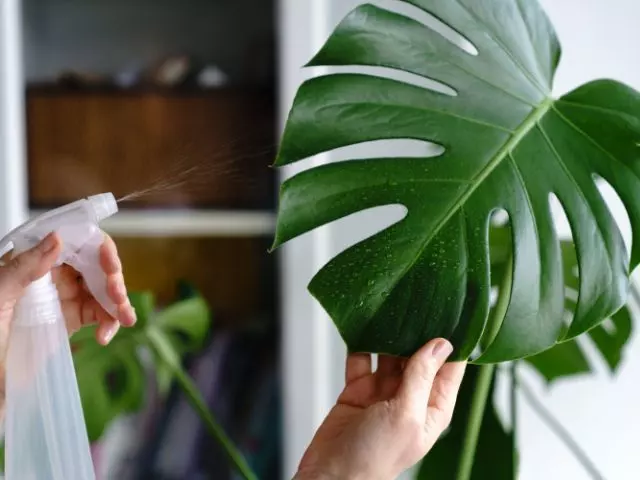Underwatering and overwatering are prevalent problems with Monstera. So, how often do you water Monstera? Finding the perfect watering schedule for your Monstera can be a bit of a puzzle, as these plants have unique needs and preferences. Overwatering can lead to root rot, while underwatering can cause its leaves to lose their characteristic vigor. This post summarizes How Often to Water Monstera Plants, giving you the essential knowledge and pro tips to keep your Monstera thriving.
Table of Contents
How Often to Water Monstera
Both underwatering and overwatering are bad for the Monstera. Not only is the amount of water the Monstera receives essential, but the substrate of the Monstera and the pot have enough drainage holes. If the substrate is not adequate with good drainage, it can cause root rot in the Monstera.
Watering a Monstera in winter is not the same as watering a Monstera in summer. Maintaining the well-being of your Monstera requires a careful equilibrium, ensuring it receives sufficient moisture without saturating the soil excessively, as this could result in overwatering and root rot. Striking this delicate balance is essential to keep your Monstera in its prime condition.
So, how often to water Monstera? When you see the first two inches (5 cm) of the surface of the substrate is dry, it is time to start watering the Monstera. You can quickly check this by inserting a stick into the substrate, and if it comes out wet, you should not water it yet. If the stick comes out dry, your Monstera needs watering.
Also, you can use a moisture meter, they are very inexpensive, and with this little device, you will be able to know how moist the substrate of your Monstera is. I currently have a 3 in 1 moisture meter (pH, moisture, and light) that does not need batteries. When you notice that the meter is at 3 or 4, it is time to water the Monstera. You can use the same moisture meter we use by clicking here.
How Often to Water Monstera in Summer
In the summer, when the Monstera is in its active growing phase, and the temperatures are warmer, its watering needs tend to increase. The combination of higher temperatures and more sunlight leads to faster moisture evaporation from the soil, making it necessary to adjust the watering frequency accordingly.
The general guideline for watering your Monstera in the summer is to water it more frequently than during winter. However, it’s crucial not to overwater, as excess moisture can lead to root rot and other issues. The key is to strike a balance and let the plant’s specific needs guide your watering routine.
To determine how often to water Monstera in summer, follow these steps:
Check the soil: Before watering, assess the top few inches of the soil. If it feels dry to the touch, it’s a sign that your Monstera may need water.
Consider the environment: Consider factors like the outdoor temperature, humidity levels, and sunlight your Monstera receives. Hotter and drier conditions will likely require more frequent watering.
Observe the plant: Pay attention to your Monstera’s leaves. If they appear droopy or if the plant shows signs of thirst, it’s time to water.
Water thoroughly: When you water, do so until you see water coming out of the drainage holes at the bottom of the pot. Doing so guarantees that all parts of the root system receive sufficient hydration.
Avoid waterlogging: Always make sure the pot has good drainage to prevent water from sitting in the soil, which can lead to overwatering.
Generally, in the summer, you may need to water your Monstera every 1-2 weeks, depending on the factors mentioned above. However, observing the plant’s specific needs is essential, then adjusting the watering frequency. By providing the right amount of water, your Monstera will thrive, displaying its stunning foliage and rewarding you with a green oasis throughout the summer.
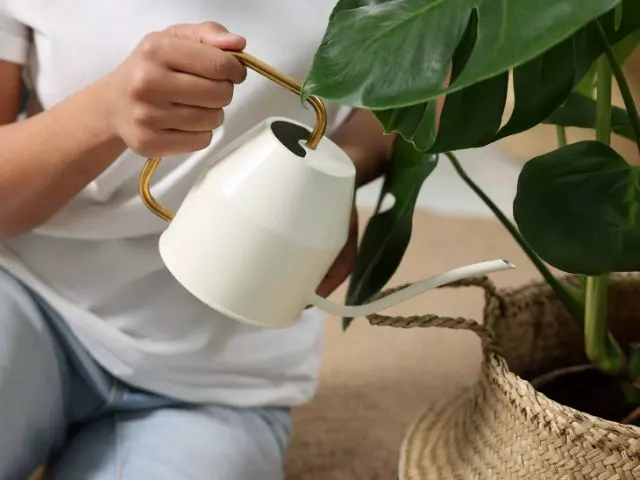
How Often to Water Monstera in Winter
During the winter months, the watering needs of your Monstera change due to the cooler and often drier indoor conditions. As the plant’s growth slows, it requires less water than the active growing season. The general rule for watering your Monstera in winter is to reduce watering frequency.
Instead of following a strict schedule, adjusting your watering routine based on the plant’s specific needs is best. Before watering, check the soil’s moisture level by feeling the soil’s top inch or two (2.5/5 cm) with your fingers.
If the soil feels dry, that indicates your Monstera may need water. On the other hand, if the soil retains some moisture, it’s better to hold off on watering.
Be cautious not to overwater during this time, as colder temperatures and reduced light can slow down the plant’s ability to absorb water, potentially leading to issues like root rot. Always aim for well-draining soil, and ensure that any excess water can drain away from the pot.
In essence, water your Monstera sparingly during the winter, about once every 14 to 21 days. This approach will help your Monstera stay healthy and happy throughout the colder months, preparing it to thrive once the growing season returns in spring.
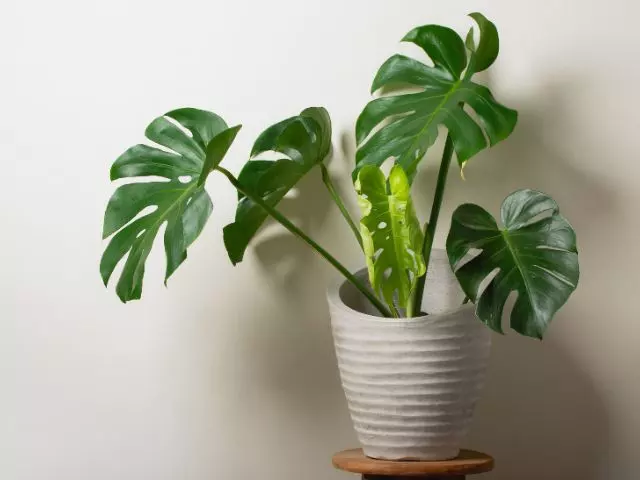
How Often to Water Monstera Adansonii
Watering frequency for Monstera adansonii, commonly known as the Swiss cheese plant or monkey mask plant, follows similar principles to other Monstera varieties.
You should water your Monstera adansonii in the summer more often than in winter. Always check how moist the substrate is before watering your Monstera adansonii.
It is essential to use a suitable substrate for your Monstera adansonii. This will ensure proper drainage and moisture retention. Also, always check that the pot has enough drainage holes. I recommend you read our article about the best soil for Monstera.
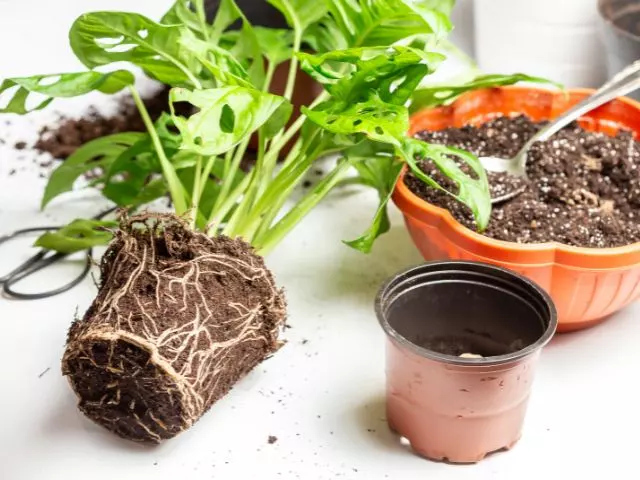
How Often to Water Monstera Deliciosa
Watering frequency for Monstera deliciosa, also known as the Swiss cheese plant or split-leaf philodendron, depends on various factors such as environmental conditions, season, and plant size. Before watering your Monstera deliciosa, ensure the first few inches of the substrate is dry. As I mentioned before, using a substrate suitable for Monstera is crucial. This way, you will favor drainage and moisture retention. You can also use self-watering pots to properly maintain your Monstera.
In addition to watering the Monstera correctly, fertilizing is very important. I recommend you read our article Monstera fertilizer: how and when to fertilize.
- 【Different Size Combo】These plastic planters indoor combines with 5 different sizes, which are suitable for planting most small and medium-sized home/office plants works well with orchid, cactus, succulents, aloe vera, basil, flowers, Peace Lily,air plants, snake plant to brighten up your living place,
- 【Modern Simple Design】A simple modern aesthetic and clean matte finish planters indoor plants bringing out a minimalistic styled. the pots are perfect for indoor plants of different colors ,brings out a modern stylish visual representation for any home/office decor without any sense of violation.
- 【Excellent Drainage Holes and Watering Lip】These flower pots for plants come with multiple drainage holes in the bottom. The holes and watering lip provide an air circulation system for the plant roots, which greatly reduces the problem of root rot of plants in a closed environment. The independent watering lip replenishes water for plants, so that water does not have to pass through the plant itself, At the same time, it is convenient to observe the current water level.
Signs of an Overwatered Monstera
Overwatering is one of the most common problems when watering Monstera. Here are the signs of overwatering Monstera:
Wilting: Surprisingly, excessive watering on Monstera can cause leaves to wilt, as can underwater watering. That happens because excessive moisture in the soil prevents the roots from absorbing oxygen properly, leading to wilting and drooping leaves.
Yellowing leaves: If you notice the leaves of Monstera yellowing, especially the lower leaves, it could be a sign of overwatering. Overwatered soil lacks adequate aeration, and the roots can begin to suffocate, causing the leaves to turn yellow.
Mold or fungus growth: Overly damp soil creates a perfect environment for mold and fungus to thrive. If you see white mold on the soil surface or detect a musty smell, it indicates excessive moisture.
Root rot: Overwatering is the primary cause of root rot, where the roots become waterlogged, begin to rot, and turn brown or black. Affected roots lose their ability to take up water and nutrients, further exacerbating the plant’s condition.
To avoid overwatering the Monstera, adjust the watering frequency and check the substrate’s moisture, as mentioned above, by checking the first few inches of the substrate. If the substrate does not have good drainage or the pot is not adequate, it is best to repot the Monstera to save it. I recommend you read our article on how and when to repot Monstera.
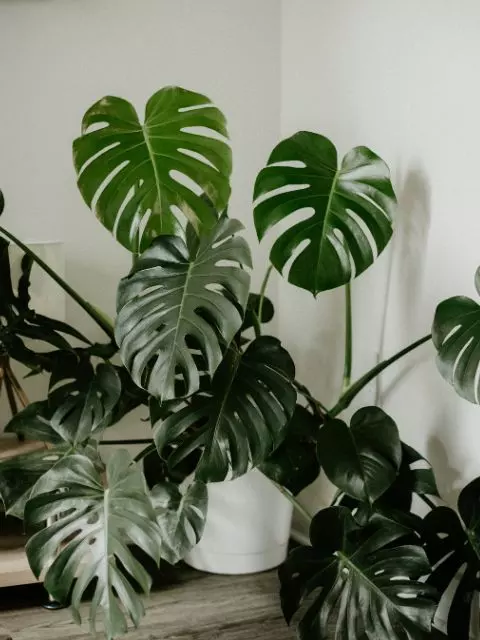
Signs of an Underwatered Monstera
Insufficient watering can pose an equal threat to your Monstera health, but fortunately, it is simpler to remedy. The initial warning signs include drooping and curling leaves, indicating the plant’s attempt to retain moisture. Additionally, the leaves might become thin and develop browning along the edges. However, the most evident signal is dry and compacted soil, serving as a clear indication that your Monstera is urgently in need of water.
In such situations, it’s advisable to begin with bottom watering. By doing so, the soil gets thoroughly soaked, eliminating any dry spots near the roots. After allowing the excess water to drain, you should notice the leaves returning to normal within a few hours.
Final Conclusions about Watering Monstera Plants
I trust that I’ve addressed all your inquiries regarding how often to water Monstera and provided solutions for any problems you might face. Remember, it’s normal to encounter challenges while caring for houseplants, and that’s part of the joy of nurturing them. Embrace the learning process, allowing you to improve your plant care skills over time. With patience and dedication, you’ll become a pro at tending to your green companions.
